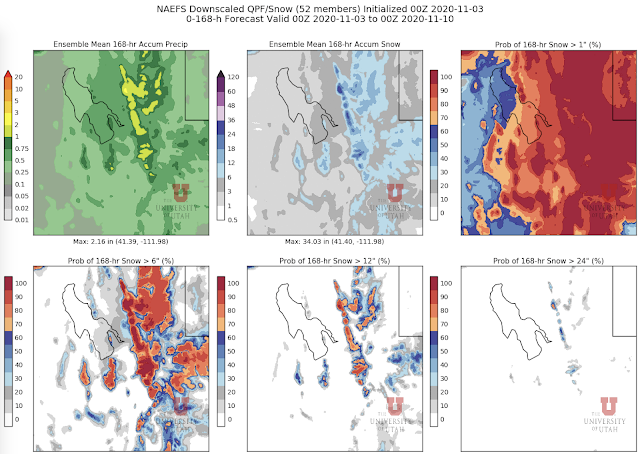Forget about the Presidential election. Changes are coming to Utah weather, so start looking at forecasts instead of vote counts. Indeed, there's plenty to hope and argue about in the forecast below.
I'm having some software problems this morning, so apologies for the garish colors in the loop below which shows either radar or modeled precipitation and the 500-mb (upper-level) flow pattern from 1200 UTC 5 November (5 AM MST Thursday) through 0600 UTC 8 November (11 PM MST Sunday). The pattern is one that features what we call a "digging" upper-level trough. That's a trough that instead of moving eastward, moves equatorward and amplifies.
Really, that's not a best-case scenario for snow in the Cottonwoods for a few reasons. One is that the "dynamics" associated with the upper-level trough pass to our south. Another is that the flow stays more southerly or southwesterly.
However, this is a deep, cold, unstable trough. Although it's not an ideal situation, it is going to give us more precipitation than we've seen around here in some time.
In the interest of time, I'm going to summarize the situation through the weekend using a time-height section (see Forecast Tools: The Time-Height Section for more information). The one below shows how wind (barbs), relative humidity (color fill), freezing level (blue line), and a thermodynamic quantity known as equivalent potential temperature that combines temperature and moisture (back contours) evolve over time. By convention, time increases to the left not right. I've identified four key periods with colored boxes.
In the first (brown box), strong southerly flow predominates with low relative humidity at low levels, high freezing levels, and high relative humidity at upper levels. This period, which will predominate today and tonight, will be windy and mild with dangerous fire-weather conditions (the National Weather Service has issued a Red Flag Warning for this period for all of western Utah including the Salt Lake Valley).
Tomorrow morning and early afternoon (blue box) will be a transition period with perhaps some fits and starts of precipitation at times. Freezing levels will lower slightly, but snow levels will be fairly high., perhaps near 9000 feet at 5 AM and lowering to 8000 feet in the early afternoon.
Precipitation will increase and temperatures will lower later in the afternoon or in the early evening as cold air moves into northern Utah (purple box). Expect some stronger showers and there's even the chance of a thunderstorm. Wouldn't that be exciting!
Later Saturday night and Sunday (red box) we have a period of post-frontal instability. Unfortunately for the Cottonwoods, the flow never comes around to northwesterly, but remains predominantly southerly to westerly. Still they will get some snow.
Let's look at a few numbers for Alta-Collins (9700 feet). Through 5 PM Sunday the NAM is producing 0.67" of water and 6" of snow. The GFS, which is typically wetter (and often too wet), is much more enthusiastic and produces 1.77" of water and 23" of snow. I don't have precise numbers from the ECMWF, but it's around 1.2" for the same period.
If we look at the SREF ensemble, 5 PM Sunday equates with 09/0Z in the plumes below. The range for snowfall by that time is from light accumulations up to about 20". That's a big range, which reflects uncertainty in the track of the upper level flow and the areas of precipitation accompanying it.
In contrast, the NAEFS ensemble members are skewed to higher numbers. Again, looking through 00z 09-Nov, they are putting out 0.5 to 2.5 inches of water and 9-40" of snow (I've thrown out the highest and lower members for the snow range range).
My view of all this based on the large-scale pattern and potential for instability is that the SREF is probably too pessimistic and the NAEFS is probably too optimistic. I would probably throw out the lowest SREF members and the highest NAEFS members and lean toward 0.5-1.0" of water and 6-12" of snow at Alta-Collins for the period ending 5 PM Sunday. I think to do better we will need something exciting to happen, like a really strong period of precipitation as the cold air moves in or behind the front.
Thus, I'm not expecting to be skiing this weekend. However, if you look at the NAEFS forecast above, there are chances for more precipitation later in the forecast period and the extended beyong that is suggestive we will continue to see action.
Keep your fingers crossed and hope that this transition to a colder pattern also delivers the goods.

















































